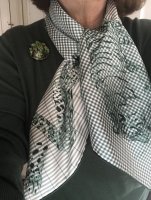Oh my, this is fabulous, Bruxelles. Those tigers warm my heart.Carré Kantha. After the traditional Indian Kantha embroidery textile art---very interesting history of Kantha, similar in many ways to quilting art forms, telling stories, using recycled scraps of fabric, simplicity of materials creating gorgeous works!
Kantha refers to the simple running stitch used well as the cloth as a whole. Notice the "H" motif worked in...Hermès humor at work!
View attachment 5272585
Love the two sweet Bengal tigers!
View attachment 5272586
There is also some background "stitching" that almost appears to be a jacquard pattern--it is flat and printed, but very 3-D.
View attachment 5272587
You are using an out of date browser. It may not display this or other websites correctly.
You should upgrade or use an alternative browser.
You should upgrade or use an alternative browser.
Scarves Scarf of the Day 2021 - Which Hermès scarf are you wearing today?
- Thread starter bunnycat
- Start date
TPF may earn a commission from merchant affiliate
links, including eBay, Amazon, and others
- Status
- Not open for further replies.
More options
Who Replied?How perceptive of you to pick that out, Xincinsin. Two different artists with similar renderings. Looks like we are twins on both!That Ors Bleus is absolutely glowing!
But it's the Minoan dolphins which caught my eye. They take centrestage on Les Secrets de Minos.
View attachment 5271784
And these on Animapolis look like kissing cousins!
View attachment 5271785

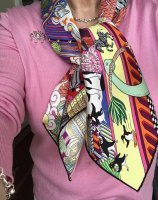
Big kitties...but the big cats always remind me more of my Goldens! Thank you, Karenska!Oh my, this is fabulous, Bruxelles. Those tigers warm my heart.
What a great CW of this design, RBH!Thank you, @Living.la.vida.fifi , for your wonderful introduction to this week’s theme of Scarf Imitates Art. And, thank you, @Cookiefiend , for hosting last week’s theme of repeated design elements.
This past year I decided that I needed more red scarves in my collection, and made a concerted effort to add them. I found the shades of red in recent seasons were not to my liking, so I began looking at vintage designs. I tagged this bright red scarf with the blue ducks (no name, TRR had it listed simply as “Hermes silk scarf”), and watched for weeks as the price dropped and dropped. Finally I threw it into my cart (after all, with all the discounts, according to H Math it was practically free) and it was mine.
Scarf in hand, I pulled out my Carrés d’art IV and identified it as La Mare aux Canards, 1981, by Daphné Duchesne.
View attachment 5271915
Turning to @marietouchet in the Authentication thread. "Mare aux canards is an all time favorite of mine. It is supposed to look like cloisonne. Think Chinese vase ware. The ducks definitely look Chinese cloisonne - you can see the cloisons - where the metal would stick up to hold each color of enamel. The background has a basse taille look - where they engraved the bottom of the piece and would have used a transparent enamel - think Fabergé. And in certain colorways the background recedes - kinda 3D like."
View attachment 5271923
View attachment 5271924
My Scarf of the Day is La Mare aux Canards. With its repeated elements of cloisonné ducks, it is my crossover scarf this Sunday.
View attachment 5271933
Very elegant, LKBNOLA!Scarf Mail! And perhaps stretching the theme a bit to include my new Paperoles? (explanation of the inspiration below) Dear @Croisette7 said I must have one and I aim to please! Won this in an Ebay auction-- I was the only bidder on a NIB with tags. I plan to wear it to Holiday Tea at the Windsor Court Hotel (a tradition my sister and I keep every year in NOLA). This scarf is so unbelievably pretty! Showing my planned outfit and perfectly matched accessories.
View attachment 5271945View attachment 5271947
"Paperoles are meticulously rolled, fine strips of paper that can be assembled to make up all kinds of objects, generally with a religious theme. They were crafted by nuns with the most marvellous dexterity. In the 1990s this rare example of a secular-themed paperole – a berline de gala, or ceremonial carriage, from the early 19th century – was found in a Florentine antiques shop. Hermès acquired it and added it to the house’s collection. The unusual object, which inspired this scarf design by Claudia Stuhlhofer‑Mayr, is remarkable in every way: the wheels can turn, the front‑wheel axle pivots, and each detail is fastidiously reproduced, from the horses’ harnesses to the coach driver’s gaiter button. Everything is made from paper and cardboard, with the exception of the carriage lining in silk, and the horses’ legs, which are carved in wood."
Fabulous, Croisette, love the neutral CW!
Your scarf fits your mug!Maxi Twilly Cut for church today
View attachment 5271997
Great colours, Nomad, and perfect pairing!My plan was to do a silk w reds and pinks with this purple jacket For a festive holiday look. But reached for this instead bc of the cold. Another addition of this top/jacket to my closet to go with more scarves lol.
View attachment 5272071
Definitely art, Karenska!Oh, a favorite design, Susie Augusta, in a special color way. Beautifully tied, too. We are sisters; here’s mine.
View attachment 5272521
Thank you, Agrume! Those two were from the days when my husband would select a scarf for my birthday or anniversary. He did a great job, didn't he? Your blouse and scarves were gorgeous...we are so used to seeing you in the turtleneck/scarf combination--haha!
Carré Kantha. After the traditional Indian Kantha embroidery textile art---very interesting history of Kantha, similar in many ways to quilting art forms, telling stories, using recycled scraps of fabric, simplicity of materials creating gorgeous works!
Kantha refers to the simple running stitch used well as the cloth as a whole. Notice the "H" motif worked in...Hermès humor at work!
View attachment 5272585
Love the two sweet Bengal tigers!
View attachment 5272586
There is also some background "stitching" that almost appears to be a jacquard pattern--it is flat and printed, but very 3-D.
View attachment 5272587
Thank you, Bruxelles, and a beautiful CW for Kantha! and thank you for the link between scarf and painting!Napoleon. Numerous tableaux in this scarf taken from artworks.
This is one, for example, is after Jean-Louis David's "Napoleon Crossing the Alps" View attachment 5272589
View attachment 5272590
My scarf on theme is Loic Dubigeon's A la Gloire de Guillaume, a paean to William the Conqueror that takes its inspiration from the famous (and fabulous) Bayeux Tapestry. I saw this in September 2019 on DH's bucket list trip to Normandy with the WWII Museum. Fortunately for me, there were more than tanks, arsenals and beaches on the trip (though I was very moved by all of it-- including wonderful lunches and dinners with Resistance fighters now in their 80s and 90s). I am lucky to have this scarf to commemorate the trip!

You can see how close to his source he stayed from the Tapestry itself:


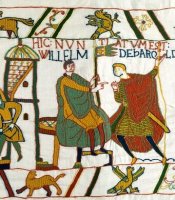

You can see how close to his source he stayed from the Tapestry itself:



Thank you, Agrume!What a great CW of this design, RBH!
Very elegant, LKBNOLA!
Fabulous, Croisette, love the neutral CW!
Your scarf fits your mug!
Great colours, Nomad, and perfect pairing!
Definitely art, Karenska!
Thank you, Bruxelles, and a beautiful CW for Kantha! and thank you for the link between scarf and painting!
Twins! ... nicely tied with Mors!My scarf on theme is Loic Dubigeon's A la Gloire de Guillaume, a paean to William the Conqueror that takes its inspiration from the famous (and fabulous) Bayeux Tapestry. I saw this in September 2019 on DH's bucket list trip to Normandy with the WWII Museum. Fortunately for me, there were more than tanks, arsenals and beaches on the trip (though I was very moved by all of it-- including wonderful lunches and dinners with Resistance fighters now in their 80s and 90s). I am lucky to have this scarf to commemorate the trip!
View attachment 5272655
You can see how close to his source he stayed from the Tapestry itself:
View attachment 5272656View attachment 5272657View attachment 5272658
How did I miss this post, LKBNOLA? Stunning and and absolutely beautiful cw. Perfect with your sweater. Thank you for the background information.Scarf Mail! And perhaps stretching the theme a bit to include my new Paperoles? (explanation of the inspiration below) Dear @Croisette7 said I must have one and I aim to please! Won this in an Ebay auction-- I was the only bidder on a NIB with tags. I plan to wear it to Holiday Tea at the Windsor Court Hotel (a tradition my sister and I keep every year in NOLA). This scarf is so unbelievably pretty! Showing my planned outfit and perfectly matched accessories.
View attachment 5271945View attachment 5271947
"Paperoles are meticulously rolled, fine strips of paper that can be assembled to make up all kinds of objects, generally with a religious theme. They were crafted by nuns with the most marvellous dexterity. In the 1990s this rare example of a secular-themed paperole – a berline de gala, or ceremonial carriage, from the early 19th century – was found in a Florentine antiques shop. Hermès acquired it and added it to the house’s collection. The unusual object, which inspired this scarf design by Claudia Stuhlhofer‑Mayr, is remarkable in every way: the wheels can turn, the front‑wheel axle pivots, and each detail is fastidiously reproduced, from the horses’ harnesses to the coach driver’s gaiter button. Everything is made from paper and cardboard, with the exception of the carriage lining in silk, and the horses’ legs, which are carved in wood."
Beautiful, Nomad. You wear these colors so well.My plan was to do a silk w reds and pinks with this purple jacket For a festive holiday look. But reached for this instead bc of the cold. Another addition of this top/jacket to my closet to go with more scarves lol.
View attachment 5272071
So lovely and the renderings are really true to the original. And a wonderful souvenir of a very special trip. It’s on my short list, for sure.My scarf on theme is Loic Dubigeon's A la Gloire de Guillaume, a paean to William the Conqueror that takes its inspiration from the famous (and fabulous) Bayeux Tapestry. I saw this in September 2019 on DH's bucket list trip to Normandy with the WWII Museum. Fortunately for me, there were more than tanks, arsenals and beaches on the trip (though I was very moved by all of it-- including wonderful lunches and dinners with Resistance fighters now in their 80s and 90s). I am lucky to have this scarf to commemorate the trip!
View attachment 5272655
You can see how close to his source he stayed from the Tapestry itself:
View attachment 5272656View attachment 5272657View attachment 5272658
It is a wonderful scarf, with a story to tell and precious memories, thank you for sharing.My scarf on theme is Loic Dubigeon's A la Gloire de Guillaume, a paean to William the Conqueror that takes its inspiration from the famous (and fabulous) Bayeux Tapestry. I saw this in September 2019 on DH's bucket list trip to Normandy with the WWII Museum. Fortunately for me, there were more than tanks, arsenals and beaches on the trip (though I was very moved by all of it-- including wonderful lunches and dinners with Resistance fighters now in their 80s and 90s). I am lucky to have this scarf to commemorate the trip!
View attachment 5272655
You can see how close to his source he stayed from the Tapestry itself:
View attachment 5272656View attachment 5272657View attachment 5272658
Yes, definitely a work of art!More Dallet as SOTD. Dans l’Atelier de Robert Dallet. This is quite a stiff silk but I love it. The brooch is Russian hand-painted on wood.
View attachment 5272664
SOTD was Jardin des métamorphoses, by François Houtin. I had the blue one, but applied LKBNOLA‘s CCP after I found my favourite colourway. Houtin was first a landscape gardener before he learned how to do etchings. Apparently he likes doing leporellos. I enclose some (parts) of the etchings we have at home, many are cherished presents of a friend (including the leporello).
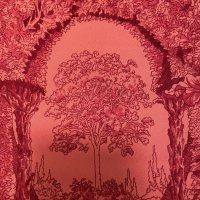
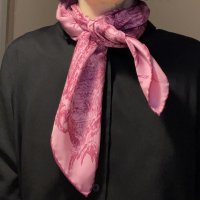
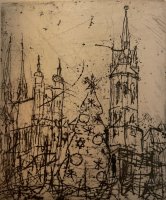
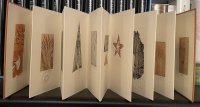






Thank you so very much for your lovely comment, dear momaAmazing research into all the source material! Thanks. I especially love the pink/grey CW of ModTrop - I grew up with a bathroom in those colors (1950s).
Pytheas is endlessly fascinating, and I love the references you dug up - I never found a CW that I loved, so I don't have this scarf - must admire yours.
Love that you highlighted these delightful dolphinsThat Ors Bleus is absolutely glowing!
But it's the Minoan dolphins which caught my eye. They take centrestage on Les Secrets de Minos.
View attachment 5271784
And these on Animapolis look like kissing cousins!
View attachment 5271785
Thank you so much for your beautiful comment… It means so much coming from you! I didn’t recognize Tresors d’un Artiste at first from this knot! It is gorgeous and the perfect introductory scarf for the week’s theme. The style and layout of the illustration reminded a bit of a Matisse still-lifeThank you so much to dear @Cookiefiend for hosting such a dynamic and fun week. I really enjoyed all the variations and people's comments on rhythm and repetition in designs. And always love seeing your wonderful examples!
And thank you to this week's hostess for an amazing and wonderfully researched introduction! You could really be an H docent @Living.la.vida.fifi -- your knowledge is so deep and your collection is so comprehensive. It allows you to illustrate every point. I am twins with two of your examples and sisters on Pytheas. I echo @xincinsin on your Ors Bleu-- just electrically gorgeous. While I take in this introduction and come up with inspiration, I will post a shot of a scarf that imitates the tools of art! Les Tresors d'un Artiste with its paintbrushes and palette. It could be a "crossover" a la Redbird since it also has a lot of rhythmic elements in the design!
View attachment 5271806
Such a fabulous design and amazing in this vibrant CW! The details resembling cloisonné are so intricate and beautifulThank you, @Living.la.vida.fifi , for your wonderful introduction to this week’s theme of Scarf Imitates Art. And, thank you, @Cookiefiend , for hosting last week’s theme of repeated design elements.
This past year I decided that I needed more red scarves in my collection, and made a concerted effort to add them. I found the shades of red in recent seasons were not to my liking, so I began looking at vintage designs. I tagged this bright red scarf with the blue ducks (no name, TRR had it listed simply as “Hermes silk scarf”), and watched for weeks as the price dropped and dropped. Finally I threw it into my cart (after all, with all the discounts, according to H Math it was practically free) and it was mine.
Scarf in hand, I pulled out my Carrés d’art IV and identified it as La Mare aux Canards, 1981, by Daphné Duchesne.
View attachment 5271915
Turning to @marietouchet in the Authentication thread. "Mare aux canards is an all time favorite of mine. It is supposed to look like cloisonne. Think Chinese vase ware. The ducks definitely look Chinese cloisonne - you can see the cloisons - where the metal would stick up to hold each color of enamel. The background has a basse taille look - where they engraved the bottom of the piece and would have used a transparent enamel - think Fabergé. And in certain colorways the background recedes - kinda 3D like."
View attachment 5271923
View attachment 5271924
My Scarf of the Day is La Mare aux Canards. With its repeated elements of cloisonné ducks, it is my crossover scarf this Sunday.
View attachment 5271933
Oooh, I think that the retro living room idea is fantastic! I will find the pics I saved and share them with you via PMAwww- thank you! This is another "magic scarf". While I like it flat, it really seems to "come together" once tied and elevates whatever I am wearing. I don't know how else to describe it. But if I look "acceptable" before I put this one on, once it is on I feel va-voom!(Not all of my scarves do this, only a few...those are the "magic" ones). Give Ponki a big snuggle!!
Thank you Barbette!
Indeed! What a fabulous thought for a repeat!
What a fantastic intro fifi! Looks like I get to wear Modernism tropical again this week!I absolutely adore the Retro living room image you have used here so much I screen-shotted it and am now currently pondering whether I can cross our living room over to something like this. I feel I have been waiting 7 years for inspiration on our rather dark living room space! It may need this kind of drama!
Thank you Croisette!
Thank you kindly LKB!
You color and pattern mixing is astounding!!! Beautiful LKB!
Thank you Nomad!
Thank you kindly Agrume!
The cloisonné effect really comes out superbly in this color way rbh! Stunning, bright colors make this so cheerful!
Not stretching it at all! This is right on topic! A gorgeous CW and I adore the red hem echoing the colors of parts of the design. Love your accessories flat-lay, especially the flowered hat! I can imagine how chic you will have looked wearing these!Scarf Mail! And perhaps stretching the theme a bit to include my new Paperoles? (explanation of the inspiration below) Dear @Croisette7 said I must have one and I aim to please! Won this in an Ebay auction-- I was the only bidder on a NIB with tags. I plan to wear it to Holiday Tea at the Windsor Court Hotel (a tradition my sister and I keep every year in NOLA). This scarf is so unbelievably pretty! Showing my planned outfit and perfectly matched accessories.

View attachment 5271945View attachment 5271947
"Paperoles are meticulously rolled, fine strips of paper that can be assembled to make up all kinds of objects, generally with a religious theme. They were crafted by nuns with the most marvellous dexterity. In the 1990s this rare example of a secular-themed paperole – a berline de gala, or ceremonial carriage, from the early 19th century – was found in a Florentine antiques shop. Hermès acquired it and added it to the house’s collection. The unusual object, which inspired this scarf design by Claudia Stuhlhofer‑Mayr, is remarkable in every way: the wheels can turn, the front‑wheel axle pivots, and each detail is fastidiously reproduced, from the horses’ harnesses to the coach driver’s gaiter button. Everything is made from paper and cardboard, with the exception of the carriage lining in silk, and the horses’ legs, which are carved in wood."
One of my favorite winter scarves. I wore my blue CW last week… Yours is divine!
You look amazing! Love your shoes and the hat, too!Maxi Twilly Cut for church today
View attachment 5271997
Speechless… You are wearing one of my all-time Grail shawls!My plan was to do a silk w reds and pinks with this purple jacket For a festive holiday look. But reached for this instead bc of the cold. Another addition of this top/jacket to my closet to go with more scarves lol.
View attachment 5272071
Well, my favorite is the black CW but must be honest and say that every CW is marvelous and yours is dreamyThank you, Living.la.vida.fifi! Is it the Crayons that you are looking for? I hope you find it---the black cw with the true colored pencils is pretty spectacular too.
What a lovely comment… Thank you most kindly! You make all the work worthwhileSuch a fantastic introduction, Living.la.vida.fifi! I always come away with a new perspective and insight into my scarves after reading your posts. Thank you for taking the time and having the energy to share your knowledge with us!!! Not to mention sharing photos of your extensive scarf collection---oh my goodness!
Beautiful!Oh, a favorite design, Susie Augusta, in a special color way. Beautifully tied, too. We are sisters; here’s mine.
View attachment 5272521
What an amazing artpiece! Ans, when tied, it has a watercolor quality to itSOTD is Acinonyx Jubatus, based on this Robert Dallet painting.
View attachment 5272570View attachment 5272571View attachment 5272572
Love Carre Kantha so much! Though I own a green moussie, I wish I had a 90 and my fav CW is your redCarré Kantha. After the traditional Indian Kantha embroidery textile art---very interesting history of Kantha, similar in many ways to quilting art forms, telling stories, using recycled scraps of fabric, simplicity of materials creating gorgeous works!
Kantha refers to the simple running stitch used well as the cloth as a whole. Notice the "H" motif worked in...Hermès humor at work!
View attachment 5272585
Love the two sweet Bengal tigers!
View attachment 5272586
There is also some background "stitching" that almost appears to be a jacquard pattern--it is flat and printed, but very 3-D.
View attachment 5272587
Perfect scarf for the week… a pictorial classic! Glad you posted it as it had to be featured this weekNapoleon. Numerous tableaux in this scarf taken from artworks.
This is one, for example, is after Jean-Louis David's "Napoleon Crossing the Alps" View attachment 5272589
View attachment 5272590
Love them on youHow perceptive of you to pick that out, Xincinsin. Two different artists with similar renderings. Looks like we are twins on both!
View attachment 5272608View attachment 5272610
Perfect post for the week! The illustrations on the scarf are literally lifted from the original tapestry. Such a masterpiece and essential to the art lover, especially of medieval art and textiles. I was planning to post about this design but no longer have to since you so beautifully posted about it.My scarf on theme is Loic Dubigeon's A la Gloire de Guillaume, a paean to William the Conqueror that takes its inspiration from the famous (and fabulous) Bayeux Tapestry. I saw this in September 2019 on DH's bucket list trip to Normandy with the WWII Museum. Fortunately for me, there were more than tanks, arsenals and beaches on the trip (though I was very moved by all of it-- including wonderful lunches and dinners with Resistance fighters now in their 80s and 90s). I am lucky to have this scarf to commemorate the trip!
View attachment 5272655
You can see how close to his source he stayed from the Tapestry itself:
View attachment 5272656View attachment 5272657View attachment 5272658
It is fabulous! So wearable… and I love the pin!More Dallet as SOTD. Dans l’Atelier de Robert Dallet. This is quite a stiff silk but I love it. The brooch is Russian hand-painted on wood.
View attachment 5272664
Magnificent silk and extraordinary etchings! Are they contained in book format?SOTD was Jardin des métamorphoses, by François Houtin. I had the blue one, but applied LKBNOLA‘s CCP after I found my favourite colourway. Houtin was first a landscape gardener before he learned how to do etchings. Apparently he likes doing leporellos. I enclose some (parts) of the etchings we have at home, many are cherished presents of a friend (including the leporello).
View attachment 5272717View attachment 5272718View attachment 5272719View attachment 5272720View attachment 5272721
Today, I begin with a scarf from Hermès’ Fall/Winter 2021 season and a new format for me: Jan Bajtlik’s muffler L’Epopée d’Hermes. The design presents a snake and ladders game board illustrating the history and legacy of Hermès. Bajtlik’s colorful naive-style anecdotal illustrations with their fluid series of lively vignettes reminds me of comic art illustrations. After the modeling pic and collage pic of a few areas of the scarf, is a collage that presents the art of Australian artist and animator Ron Campbell, best known for his artwork on The Beatle’s Yellow Submarine, The Flintstones, The Jetsons and The Rugrats. I also include a piece by Matt Groenig creator of The Simpsons.
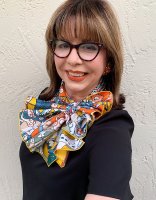

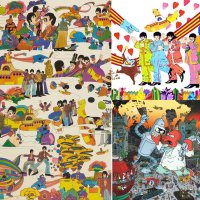
Next is Christine Henry’s Cave Felem. A design based on ancient Pompeiian mosaics, it is executed as a mosaic fragment full of delightful details. The center medallion depicts a black cat pouncing from shrubbery while the corner panels show his prey and other garden creatures in the form of adorable mice, lizards, ladybugs, snails, bees and butterflies.
The artist cites as inspiration for her piece to be the famous Cave Canem mosaic found in the House of the Tragic Poet in Pompeii. I must also cite another wonderful Pompeiian mosaic found in the Casa del Fauno which portrays a beautifully realistic pouncing cat. This interpretation is a tongue-in-cheek play on these ancient works. Following the pics of the scarf are the original Roman mosaics cited.
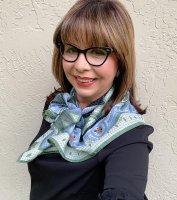

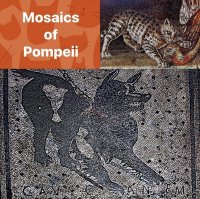
Françoise de la Perriere’s Early America pays homage to colonial America. The carré features an image of George and Martha Washington at its center executed in the simple, naive style of 18th century American portraiture and of Fraktur folk art which was a beautiful and decorative art style practiced by the Pennsylvania Dutch and German of the 17th-18th centuries. During that time, many people from the Alsace Region in Germany and Switzerland emigrated to the Pennsylvania countryside and their art aesthetic was adapted to American themes. The name Fraktur refers to the pointy quality of the writing style.
Surrounding the central graphic, there appears a delightful parade of animals, birds and children portrayed in the style of the popular American folk artform of paper cutting, or “carnivet.” In paper cutting, sheets of paper are folded several times and then painstakingly ornamented by cutting patterns with a small sharp scissors or a penknife called a carnivet. When the carefully cut sheets are unfolded they reveal designs that have a handmade feel and whimsical iconography. The beautiful designs of animals and children seem to be made made using the marble paper that was so popular in the 18th century.
Below, pics of two of my colorways. I own several CWs of this design, which is a favorite. The neutral CW below is of the original design which pictures squirrels in the center panel instead of the later portrait of George and Martha Washington.
The collage below the scarf pics depict clockwise beginning at the top left: a colonial naive-style portrait of George and Martha Washington; an 18th century sample of carnivet paper cutting art from the Met Museum; two examples of Pennsylvania German and Dutch fraktur art; and a sample of 18th century marbled paper.
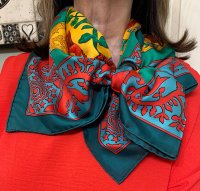
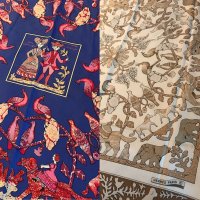

Bonnes Vibrations is a dynamic design created by Pierre Marie in 2016. This is an example of the artistic vision of the artist who is deeply interested in the interactions of complex geometric patterns, kinetic movement and decorative design.
This piece reminds me of the work of Op Art master Victor Vasarely and it has also been discussed in relation to Chladni patterns and figures, which are in essence the series of two-dimensional patterns that appear when a substance such as sand is placed on a square metal plate which is then made to vibrate at resonant frequencies by an oscillator.
Below, some pics of the scarf followed by a collage that shows an example of Chladni patterns in the upper section and paintings by Vasarely below
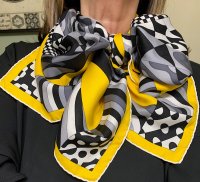
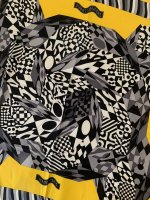
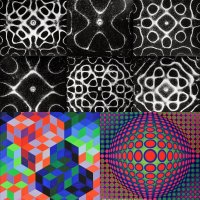



Next is Christine Henry’s Cave Felem. A design based on ancient Pompeiian mosaics, it is executed as a mosaic fragment full of delightful details. The center medallion depicts a black cat pouncing from shrubbery while the corner panels show his prey and other garden creatures in the form of adorable mice, lizards, ladybugs, snails, bees and butterflies.
The artist cites as inspiration for her piece to be the famous Cave Canem mosaic found in the House of the Tragic Poet in Pompeii. I must also cite another wonderful Pompeiian mosaic found in the Casa del Fauno which portrays a beautifully realistic pouncing cat. This interpretation is a tongue-in-cheek play on these ancient works. Following the pics of the scarf are the original Roman mosaics cited.



Françoise de la Perriere’s Early America pays homage to colonial America. The carré features an image of George and Martha Washington at its center executed in the simple, naive style of 18th century American portraiture and of Fraktur folk art which was a beautiful and decorative art style practiced by the Pennsylvania Dutch and German of the 17th-18th centuries. During that time, many people from the Alsace Region in Germany and Switzerland emigrated to the Pennsylvania countryside and their art aesthetic was adapted to American themes. The name Fraktur refers to the pointy quality of the writing style.
Surrounding the central graphic, there appears a delightful parade of animals, birds and children portrayed in the style of the popular American folk artform of paper cutting, or “carnivet.” In paper cutting, sheets of paper are folded several times and then painstakingly ornamented by cutting patterns with a small sharp scissors or a penknife called a carnivet. When the carefully cut sheets are unfolded they reveal designs that have a handmade feel and whimsical iconography. The beautiful designs of animals and children seem to be made made using the marble paper that was so popular in the 18th century.
Below, pics of two of my colorways. I own several CWs of this design, which is a favorite. The neutral CW below is of the original design which pictures squirrels in the center panel instead of the later portrait of George and Martha Washington.
The collage below the scarf pics depict clockwise beginning at the top left: a colonial naive-style portrait of George and Martha Washington; an 18th century sample of carnivet paper cutting art from the Met Museum; two examples of Pennsylvania German and Dutch fraktur art; and a sample of 18th century marbled paper.



Bonnes Vibrations is a dynamic design created by Pierre Marie in 2016. This is an example of the artistic vision of the artist who is deeply interested in the interactions of complex geometric patterns, kinetic movement and decorative design.
This piece reminds me of the work of Op Art master Victor Vasarely and it has also been discussed in relation to Chladni patterns and figures, which are in essence the series of two-dimensional patterns that appear when a substance such as sand is placed on a square metal plate which is then made to vibrate at resonant frequencies by an oscillator.
Below, some pics of the scarf followed by a collage that shows an example of Chladni patterns in the upper section and paintings by Vasarely below



Last edited:
- Status
- Not open for further replies.
Register on TPF! This sidebar then disappears and there are less ads!

